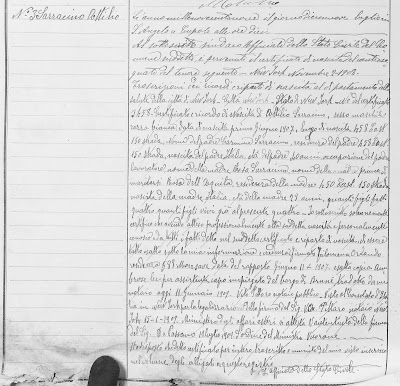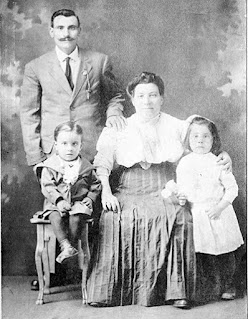Months ago I wrote about a family story that's not at all uncommon among immigrant families. (See Searching for the Missing Link in Your Family Tree.)
My great aunt Stella and her husband Attilio had the same last name—Sarracino. Stella told me they had permission to marry because they were absolutely not related.
That wasn't quite true. They weren't closely related, so it was OK for them to marry. But they were indeed cousins.
 |
| Attilio Sarracino's 1907 U.S. birth was recorded in Italy in 1909. |
I'd already collected the Pastene birth records for Stella Sarracino's parents—my great grandparents. (See How to Use the Online Italian Genealogy Archives.) Then I found the Pastene birth records for Attilio's parents, Carmine and Maria Rosa dell'Aquila.
Carmine and Maria Rosa's story is interesting:
- Carmine came to New York City in 1891 at the age of 25.
- He returned to Pastene and married Maria Rosa in 1898.
- They had a son Equilino in 1899. He was born while Carmine was spending another year in New York City.
- He returned to Pastene and had a son Carlo in 1902, and a daughter Stellina in 1903.
- In 1904, baby Carlo had died, but the rest of the family came to New York City in April.
- In 1905 their son Enrico was born in the Bronx.
- In 1907 their son Attilio was born in the Bronx.
- Between Attilio's June 1907 birth and October 1909, Carmine and Maria Rosa returned to Pastene.
Let me stop right there. In my extended family, it's rare to see a family come to America for a while, and then return to Italy.
When my genealogy research showed me that Carmine and Maria Rosa continued having children in Italy after Enrico and Attilio were born in the Bronx, I thought they had abandoned their boys. I thought they must have left them with relatives.
But why?
They continued:
- In October 1909, daughter Iolanda was born in Pastene.
- In 1911 Carmine made another trip to New York City.
- In June 1911 his daughter Antonia was born in Pastene while Carmine was in New York City.
- In 1916 Carmine was back in Pastene and his son Guido was born.
 |
| Attilio's passport photo. |
Were they ever reunited with their parents? Or did they only see their father on his occasional trips to America?
The answer was hiding in my downloaded collection of Pastene vital records.
I've been recording the facts from thousands of birth, marriage, and death records in a spreadsheet for easy searching and eventual sharing. (See How to Create Your Ancestral Hometown Database.)
While going through the 1909 birth records for Pastene, I found two records detailing the U.S. births of Enrico in 1905 and Attilio in 1907. These late entries for their births may have been required by the comune of Sant'Angelo to have a record of their inhabitants.
These late birth records are so detailed, they include the address of the house where the boys were born—458 East 150th Street. The records include the names and Bronx addresses of the witnesses to the births.
I know from Attilio's passport records that he returned to New York City in 1924. (See Your Family Tree Needs Your Ancestor's Passport Application.) I also know Enrico was in the Bronx in 1924. He testified that he recognized his brother's passport photo. He hadn't seen his brother since they were together in Italy two years earlier.
Finally this family mystery makes sense. Young Enrico and Attilio were not left behind. They did return to Italy with their parents and siblings. They each lived in Pastene until, like most young men at the time, they were old enough to make their own way in America.
I'm still piecing together facts from my downloaded vital records to discover the exact relationship between my great aunt Stella Sarracino and her dashing young husband, Attilio.



